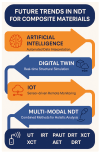Recent Trends in Non-Destructive Testing Approaches for Composite Materials: A Review of Successful Implementations
- PMID: 40649634
- PMCID: PMC12250815
- DOI: 10.3390/ma18133146
Recent Trends in Non-Destructive Testing Approaches for Composite Materials: A Review of Successful Implementations
Abstract
Non-destructive testing (NDT) methods are critical for evaluating the structural integrity of and detecting defects in composite materials across industries such as aerospace and renewable energy. This review examines the recent trends and successful implementations of NDT approaches for composite materials, focusing on articles published between 2015 and 2025. A systematic literature review identified 120 relevant articles, highlighting techniques such as ultrasonic testing (UT), acoustic emission testing (AET), thermography (TR), radiographic testing (RT), eddy current testing (ECT), infrared thermography (IRT), X-ray computed tomography (XCT), and digital radiography testing (DRT). These methods effectively detect defects such as debonding, delamination, and voids in fiber-reinforced polymer (FRP) composites. The selection of NDT approaches depends on the material properties, defect types, and testing conditions. Although each technique has advantages and limitations, combining multiple NDT methods enhances the quality assessment of composite materials. This review provides insights into the capabilities and limitations of various NDT techniques and suggests future research directions for combining NDT methods to improve quality control in composite material manufacturing. Future trends include adopting multimodal NDT systems, integrating digital twin and Industry 4.0 technologies, utilizing embedded and wireless structural health monitoring, and applying artificial intelligence for automated defect interpretation. These advancements are promising for transforming NDT into an intelligent, predictive, and integrated quality assurance system.
Keywords: X-ray computed tomography (XCT); composite materials; infrared thermography testing (IRT); multi-sensors; non-destructive testing (NDT); ultrasonic testing (UT).
Conflict of interest statement
The authors declare no conflicts of interest.
Figures










Similar articles
-
Non-Destructive Testing and Evaluation of Hybrid and Advanced Structures: A Comprehensive Review of Methods, Applications, and Emerging Trends.Sensors (Basel). 2025 Jun 10;25(12):3635. doi: 10.3390/s25123635. Sensors (Basel). 2025. PMID: 40573522 Free PMC article. Review.
-
Advancements in integrated robotic sensing: A European perspective.Open Res Eur. 2024 Jul 2;4:39. doi: 10.12688/openreseurope.16918.2. eCollection 2024. Open Res Eur. 2024. PMID: 38984169 Free PMC article. Review.
-
Recent Advancements in Wearable Hydration-Monitoring Technologies: Scoping Review of Sensors, Trends, and Future Directions.JMIR Mhealth Uhealth. 2025 Jun 13;13:e60569. doi: 10.2196/60569. JMIR Mhealth Uhealth. 2025. PMID: 40513095 Free PMC article.
-
Short-Term Memory Impairment.2024 Jun 8. In: StatPearls [Internet]. Treasure Island (FL): StatPearls Publishing; 2025 Jan–. 2024 Jun 8. In: StatPearls [Internet]. Treasure Island (FL): StatPearls Publishing; 2025 Jan–. PMID: 31424720 Free Books & Documents.
-
Nondestructive Testing of 3D Printed Fiber-Reinforced Polymeric Composites: An Experimental Critical Comparison.3D Print Addit Manuf. 2024 Jun 18;11(3):e1196-e1208. doi: 10.1089/3dp.2022.0291. eCollection 2024 Jun. 3D Print Addit Manuf. 2024. PMID: 39359573 Free PMC article.
Cited by
-
Characterization of Hard Coatings Using Acoustic Emission.Materials (Basel). 2025 Aug 12;18(16):3777. doi: 10.3390/ma18163777. Materials (Basel). 2025. PMID: 40870095 Free PMC article.
References
-
- Saghir F., Gohari S., Mozafari F., Moslemi N., Burvill C., Smith A., Lucas S. Mechanical Characterization of Particulated FRP Composite Pipes: A Comprehensive Experimental Study. Polym. Test. 2021;93:107001. doi: 10.1016/j.polymertesting.2020.107001. - DOI
-
- Ur Rahman M.S., Haryono A., Abou-Khousa M.A. Microwave Non-Destructive Evaluation of Glass Reinforced Epoxy and High Density Polyethylene Pipes. J. Nondestruct. Eval. 2020;39:26. doi: 10.1007/s10921-020-00669-2. - DOI
-
- Towsyfyan H., BiguriI A., Boardman R., Blumensath T. Successes and Challenges in Non-Destructive Testing of Aircraft Composite Structures. Chin. J. Aeronaut. 2020;33:771–791. doi: 10.1016/j.cja.2019.09.017. - DOI
-
- Gandhi N., Rose R., Croxford A.J., Ward C. Understanding System Complexity in the Non-Destructive Testing of Advanced Composite Products. J. Manuf. Mater. Process. 2022;6:71. doi: 10.3390/jmmp6040071. - DOI
-
- Gholizadeh S. A Review of Non-Destructive Testing Methods of Composite Materials. Procedia Struct. Integr. 2016;1:50–57. doi: 10.1016/j.prostr.2016.02.008. - DOI
Publication types
Grants and funding
- HICOE2.0/5210004/the Ministry of Higher Education Malaysia (MOHE) under the Higher Institution Centre of Excellence at the Institute of Tropical Forestry and Forest Products
- PM-II/SP/0040/2024/02/the Minister of Science of Poland under the name Polish Metrology II Programme
- PM-II/SP/0093/2024/02/the Minister of Science of Poland under the name Polish Metrology II Programme
- WZ/WM-IIM/5/2023/the Ministry of Science and Higher Education of Poland with allocation to the Faculty of Mechanical Engineering, Bialystok University of Technology
- WZ/WM-IIB/4/2023/the Ministry of Science and Higher Education of Poland with allocation to the Faculty of Mechanical Engineering, Bialystok University of Technology
LinkOut - more resources
Full Text Sources
Miscellaneous

